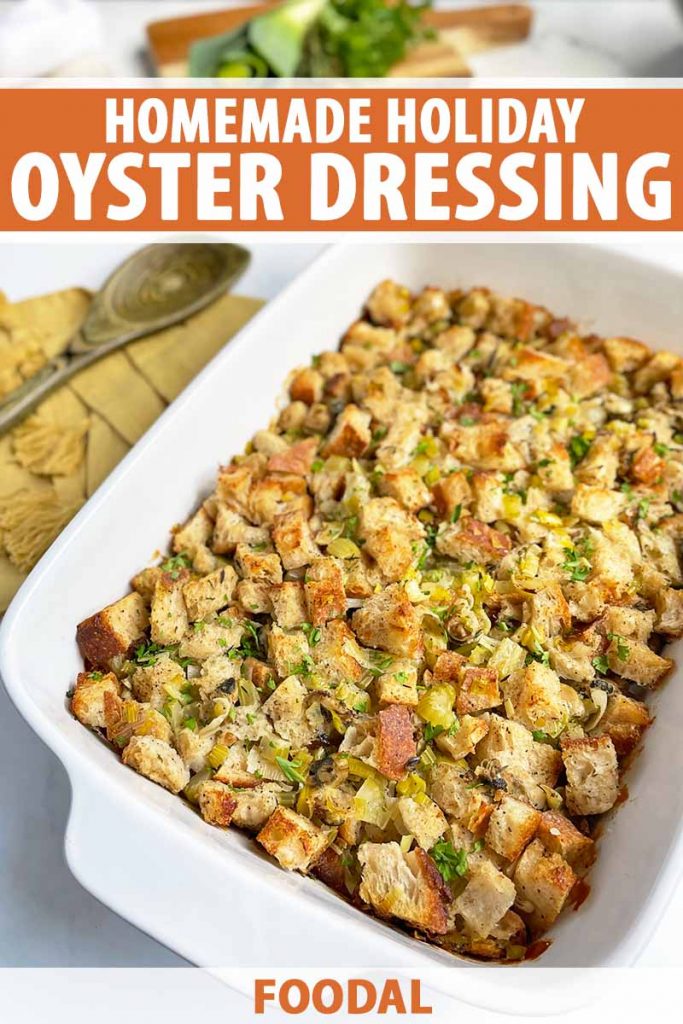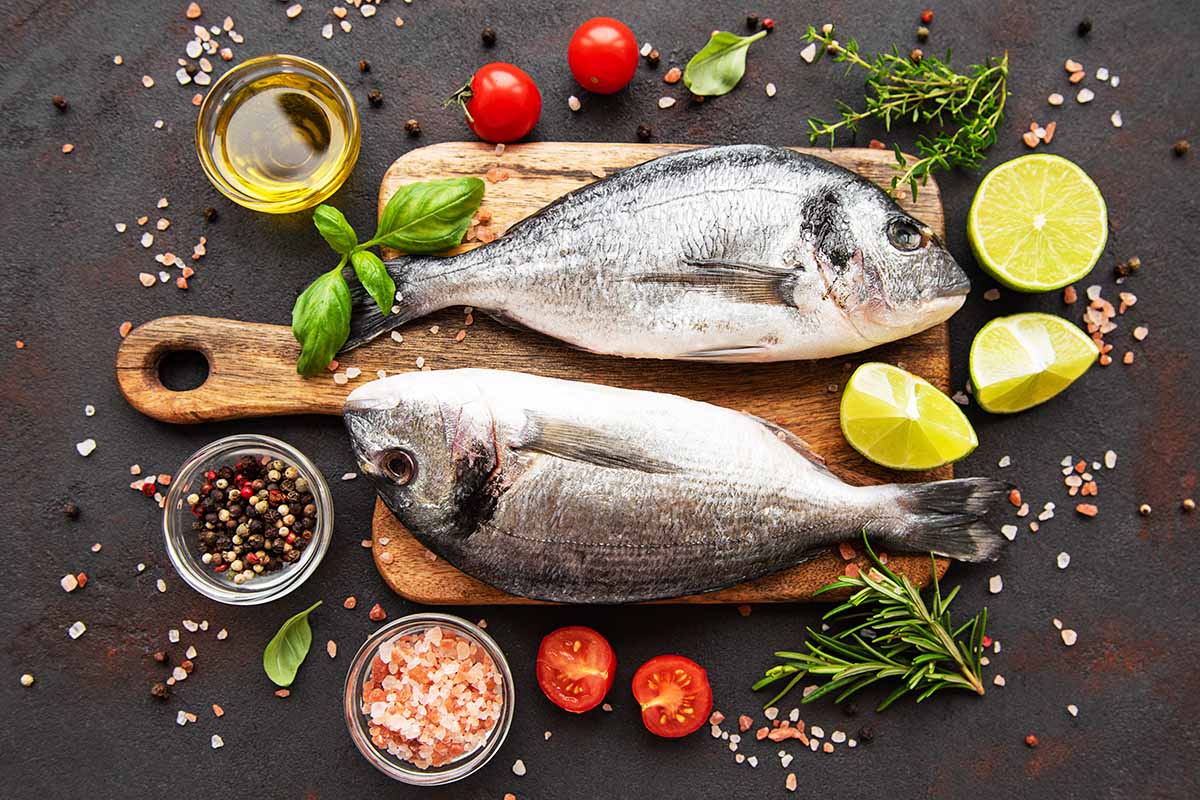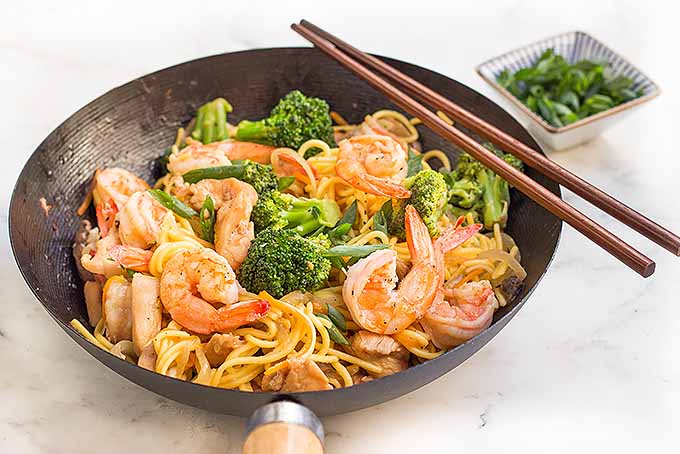You don’t need a Southern twang to whip up this coastal crowd-pleaser.
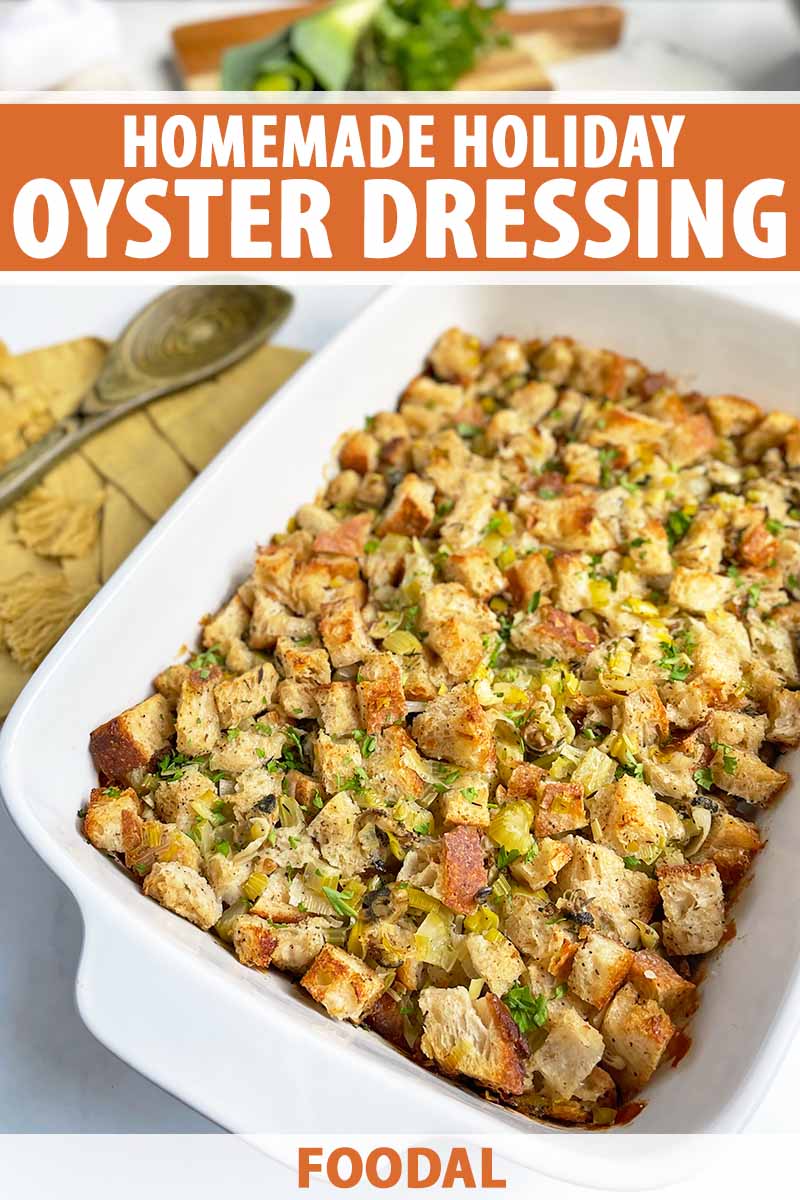
Today’s recipe mingles briny oysters with butter-drenched bread cubes and a splash of crisp, dry sherry for a Thanksgiving dressing so delicate and flavorful you’ll wonder why we shellfishly kept it to ourselves until now.
Every bite radiates with a subtle hint of salinity from the seafood and a slight sweetness from the leeks. The crusty bread absorbs all the goodness of the stock, oyster liquor, and fortified wine, with an airy bounce that melts onto your tongue and crispy edges.
If you were iffy about oyster dressing before, I bet the above description made you come out of your shell.
I admit that adding seafood to a classic stuffing was once a foreign concept to me as well.
Every Thanksgiving, my dad and I experiment with new ingredients for the starchy side. We’ve plumped dried porcini mushrooms in prosecco and tossed them into the mix. We’ve roasted garlic and chopped up dried fruit of every kind. We’ve even veered into tasty vegan stuffing territory.
But oyster dressing presented a deep dive to investigate a Southern staple we had yet to conquer.
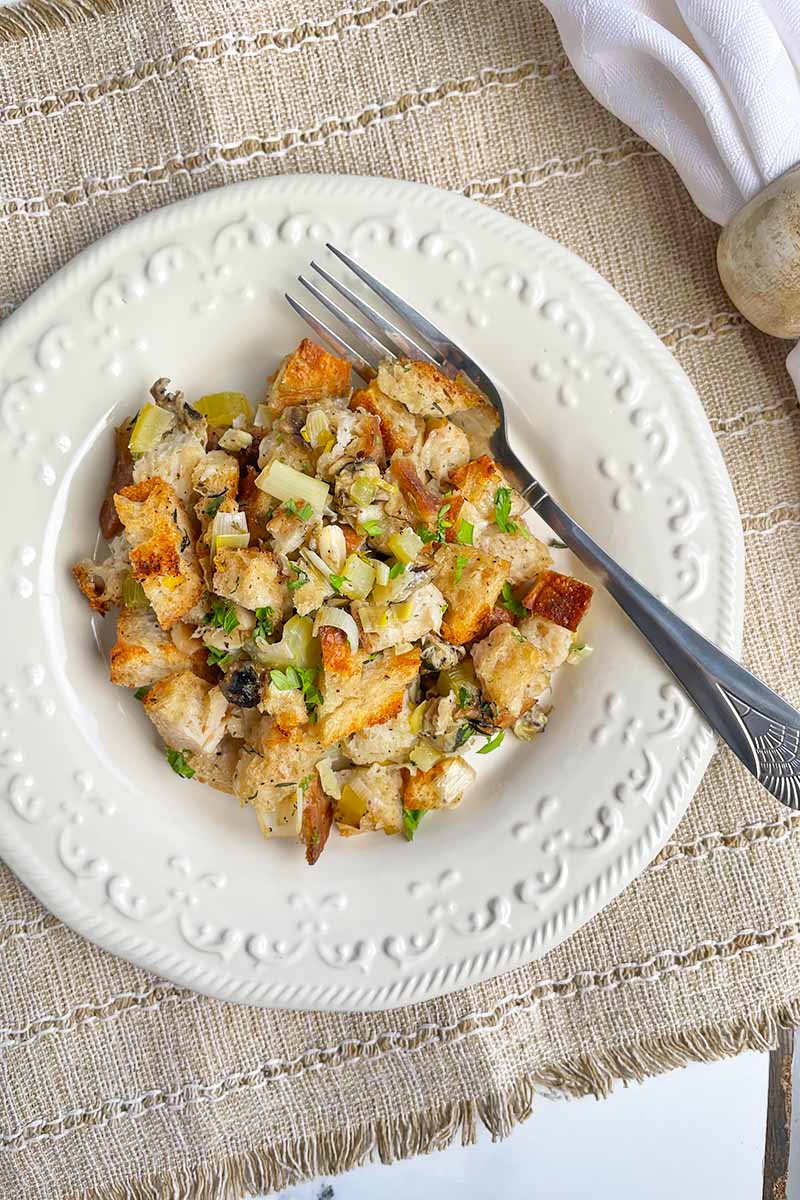
It turns out that the combination of rustic, yeasty sourdough bread, mild oniony leeks, and bright, minerally oysters is certainly something to give thanks for.
Is combining ocean fare with Thanksgiving stuffing a completely foreign notion to you? That’s cool. Pull up a chair for a brief history lesson that’s sure to leave you hungry for a bowlful of the good stuff.
Found in brackish coastal waters throughout the world, oysters have been a cultivated food item for at least 2,000 years.
With a multitude of references in British cookbooks published throughout the 17th and 18th centuries, oysters were a popular ingredient. Their use included recipes for oysters mixed with bread and seasonings used to stuff fowl, fish, mutton, calves, rabbits, and pigs.
In colonial North American history, most notably in the Chesapeake Bay region, the eastern coast was a generous source of inexpensive and nutritious oysters for British and Dutch colonists as they created new settlements.
Before oyster populations were depleted due to overharvesting, the bivalves were a dominant seafood option featured in cuisine throughout the Eastern Seaboard and Gulf Coast.
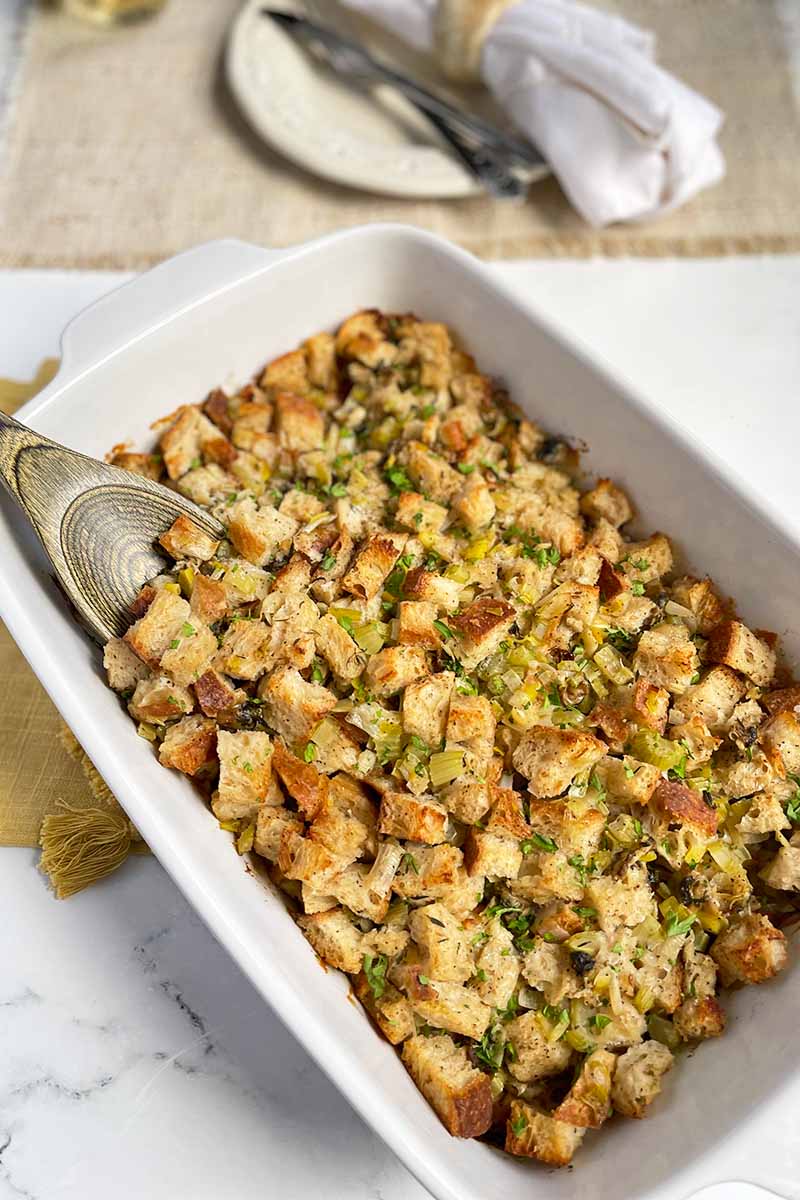
By the 1850s, the annual average harvest of oysters in the Chesapeake Bay was about 7 million bushels per year, and most of these harvests were taken from natural oyster estuaries.
As oyster demand grew, combined with more industrious harvest techniques as well as transport via train to carry oysters throughout the expanding settlements in America, the end of the 19th century saw an average increase to 15 million bushels harvested per year in the Chesapeake Bay.
Early American-produced cookbooks of the 18th and 19th centuries published in Williamsburg, Boston, and Hartford showcased a clear continuation across the East Coast of the traditions of British cookery, with recipes – such as stuffing – using fresh oysters.
Today, the oyster dressing side dish is still in the regular rotation at many holiday feasts along the Eastern Seaboard and Gulf Coast where the bivalves remain popular, though their numbers have dwindled.
If freshly shucked oysters aren’t at your fingertips, you can buy fresh raw oysters and shuck them yourself. Just, you know, watch out for your fingertips. If shucking at home, you’ll need about 12 medium or 6 large oysters for this recipe. And be sure to reserve the liquor inside the shells!

Refrigerated shucked oysters packed in water will also do the trick, but if none of these options are available, you can buy canned oysters. Just make sure to select an option that has not been smoked. If you’re not able to get that precious oyster liquor from the shell, you can use whatever liquid the oysters are packed in instead.
Speaking of liquids, sherry and oysters are a well-known celebrated pair, but you could substitute another fortified wine like vermouth or even dry white wine in a pinch. If cooking with booze isn’t for you, some non-alcoholic options include apple cider, apple cider vinegar, and white wine vinegar.
Just make sure to decrease the quantity to 1 tablespoon if you go the vinegar route to avoid an overly acidic flavor, and add 3 tablespoons of additional chicken stock to make up for the difference in volume.
No matter what you reach for to give this recipe a kick – and even if you’re not armed with a Southern drawl – this dressing is sure to make everyone at your holiday table blissfully b-oysterous.
Print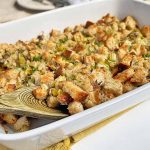
Oyster Dressing
- Total Time: 1 hour, 40 minutes
- Yield: 8-10 servings 1x
Description
Add some southern flair to your Thanksgiving table with this briny oyster dressing made with dry sherry, crusty bread, and savory leeks.
Ingredients
- 12 ounces sourdough or crusty white bread, cut into 1-inch cubes (about 8 cups)
- 6 tablespoons cold unsalted butter, divided
- 1/2 cup chopped leeks, white and light green parts only (about 2 large)
- 1 cup diced celery (about 2 stalks)
- 1 1/4 teaspoons coarse salt, plus more to taste
- 1 1/4 teaspoons freshly ground black pepper, plus more to taste
- 1/4 cup dry sherry
- 1 cup coarsely chopped shucked raw oysters, 1/3 cup oyster liquor reserved
- 1 1/2 cups low-sodium chicken stock, plus more if needed
- 2 teaspoons chopped fresh thyme
- 1 tablespoon chopped fresh parsley, for garnish
Instructions
- Preheat the oven to 250°F.
- Arrange the bread cubes on baking sheets in a single layer and bake, stirring occasionally, until dried and hardened, about 25-30 minutes. Set aside in a large mixing bowl.
- Raise the oven temperature to 400°F and lightly coat the inside of a 9-by-13-inch ceramic baking pan or a 3-quart casserole dish with nonstick cooking spray. Set aside.
- In a large skillet over medium heat, melt 2 tablespoons of the butter and swirl to coat the pan. Add the leeks and celery, season with the salt and pepper, and stir to combine. Saute until softened, about 3-5 minutes.
- Pouring slowly and scraping the bottom of the pan to deglaze it, add the sherry and chicken stock. Stir to combine and then remove the pot from the heat.
- Add the oyster liquor, chopped oysters, sherry-stock mixture, and thyme to the bowl of dried bread cubes. Toss until the bread cubes are thoroughly moistened, adding a few additional tablespoons of stock at a time if the bread looks dry or crumbly and isn’t clumping together.
- Transfer the mixture to the prepared baking dish, making sure to push the dressing all the way into the corners and smoothing the top to evenly distribute it around the pan. Cube the remaining cold butter and evenly scatter over the top.
- Tent the dish loosely with foil and bake for 20 minutes. Remove the foil, rotate the pan, and continue to bake until the top is golden brown, about 20-25 minutes. Season to taste with additional salt and pepper if necessary. Garnish with parsley and serve.
- Prep Time: 20 minutes
- Cook Time: 1 hour, 20 minutes
- Category: Stuffing
- Method: Baking
- Cuisine: Casserole
Keywords: oyster, dressing
Cooking By the Numbers…
Step 1 – Gather, Measure, and Prep Ingredients
Get out a big cutting board for your prep and a serrated bread knife. Slice the bread into 1-inch cubes and set aside in a large mixing bowl.
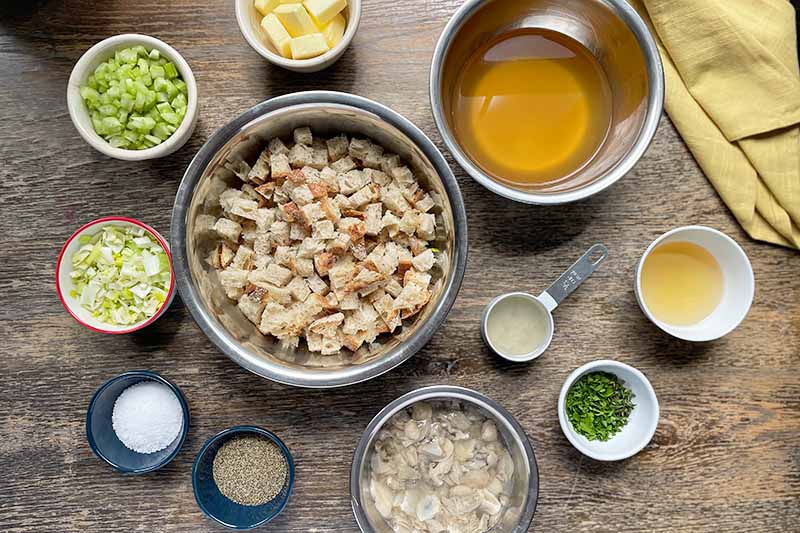
Chop the white and light green parts of the leeks. Place them in a fine mesh sieve to catch any small pieces and rinse them thoroughly under running water to make sure any sand or dirt is removed.
Dice the celery. Chop the thyme and parsley. The parsley can be reserved in the fridge until you’re ready to use it for garnish.
For some bright citrus flavor, feel free to add 2 tablespoons of fresh lemon juice to the mixture in Step 4. You can juice your lemons now, and be sure to remove any seeds.
Measure out 6 tablespoons of butter. Go ahead and cube the 4 tablespoons you’ll use in a bit while you have the cutting board out and place them in a small bowl in the fridge to stay chilled.
Measure the salt and pepper and keep your salt and pepper grinders nearby so you can season the finished dressing to taste.
Measure the sherry and chicken stock. You can also use seafood stock or vegetable stock here if you prefer, and your choice of fortified wine.
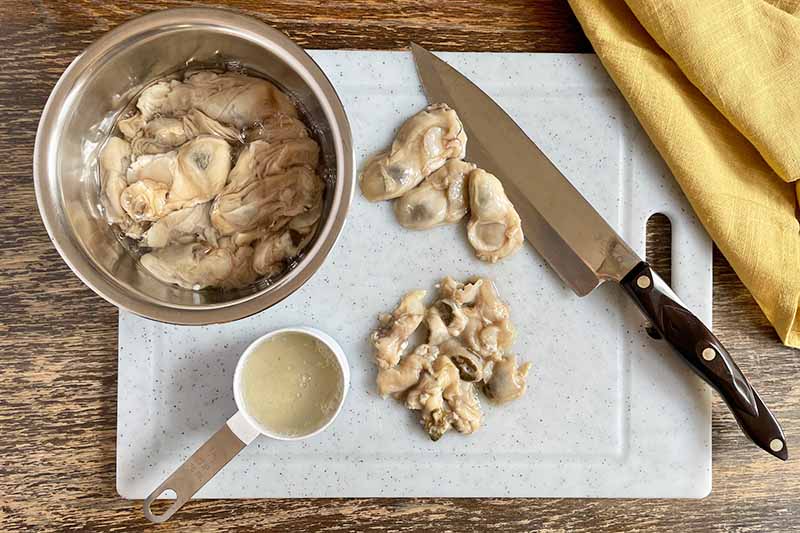
Get out a clean plastic cutting board and your oysters, and shuck them if this hasn’t been done already. Measure and set aside 1/3 cup of the oyster liquor and place the shucked oysters on the cutting board.
Oyster liquor is the flavor liquid found inside the oyster shells. If you’re using refrigerated oysters packed in water or a canned variety, the watery liquid isn’t technically oyster liquor, however it’s still very flavorful, and can be used interchangeably here.
Being careful since they’re very slippery, chop the oysters into bite-size pieces. If you’re using freshly shucked oysters, keep an eye out for any shell fragments that may be stuck to the meat and discard them.
Step 2 – Dry the Bread
Preheat the oven to 250°F and get out a few sheet pans so you have enough space to fit all the bread cubes in a single layer.
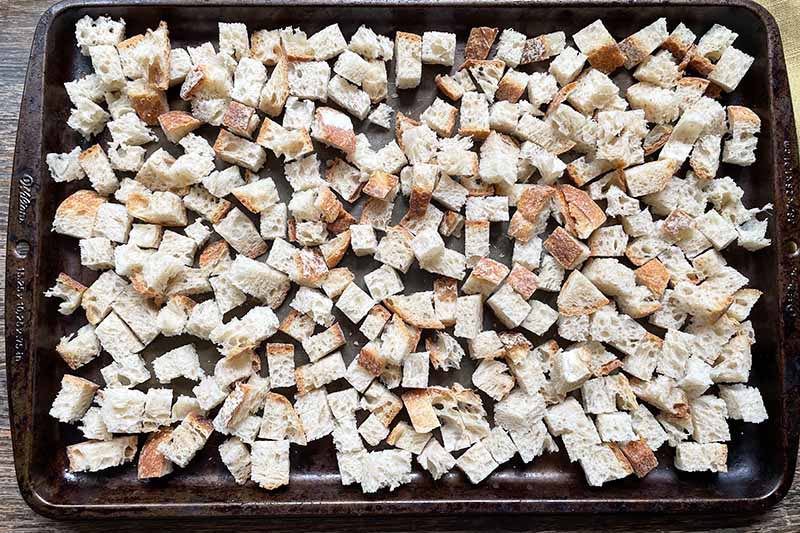
Place the bread cubes on the baking sheets. It’s okay if there’s not much space between them, but you don’t want them to be so crowded that they’re on top of each other.
Bake, stirring occasionally, until the bread is dried out, for about 25 to 30 minutes. The cubes won’t feel as hard and crunchy as croutons, but they’ll be firm when they’re ready.
Place the dried bread cubes back in the large mixing bowl and set aside.
Step 3 – Saute the Aromatics and Deglaze
Turn the oven temperature up to 400°F. Lightly coat the inside of a 9-by-13-inch ceramic baking pan or a 3-quart casserole dish with nonstick cooking spray. You could also use 1 tablespoon of butter or oil to do this.
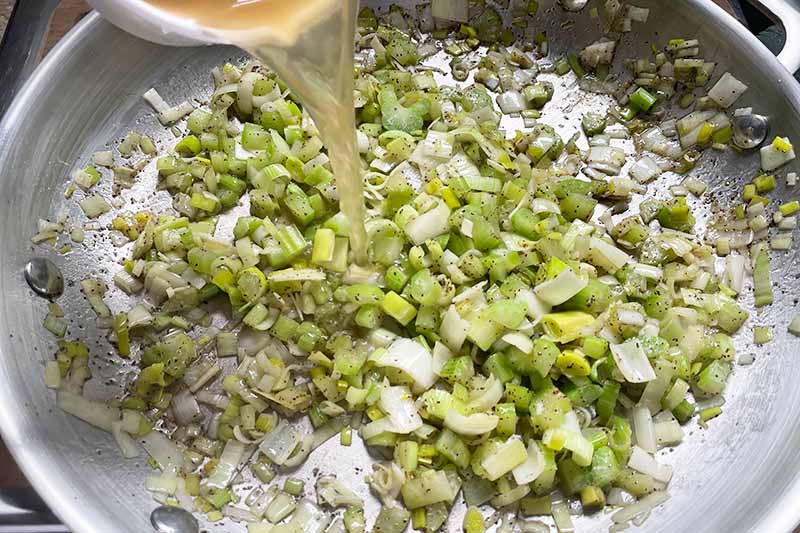
Add 2 tablespoons of the butter that you measured earlier to a large skillet over medium heat. Once the butter has melted and is just barely bubbling, add the leeks and celery and season with the salt and pepper.
Stirring the veggies occasionally, saute until they’ve softened and have become slightly translucent, about 3 to 5 minutes.
Scraping the bottom of the pan to remove any flavorful brown bits that are stuck, pour in the sherry and chicken stock. Give the mixture a stir to thoroughly combine the liquid and veggies and then take the pan off the heat.
Step 4 – Mix the Bread, Liquid, and Oysters
In the mixing bowl with the bread cubes, add the oyster liquor, chopped oysters, sherry-stock mixture, and thyme. Gently folding everything together with a spatula, toss the dressing until the bread cubes are moistened. Fold in the lemon juice, if using.
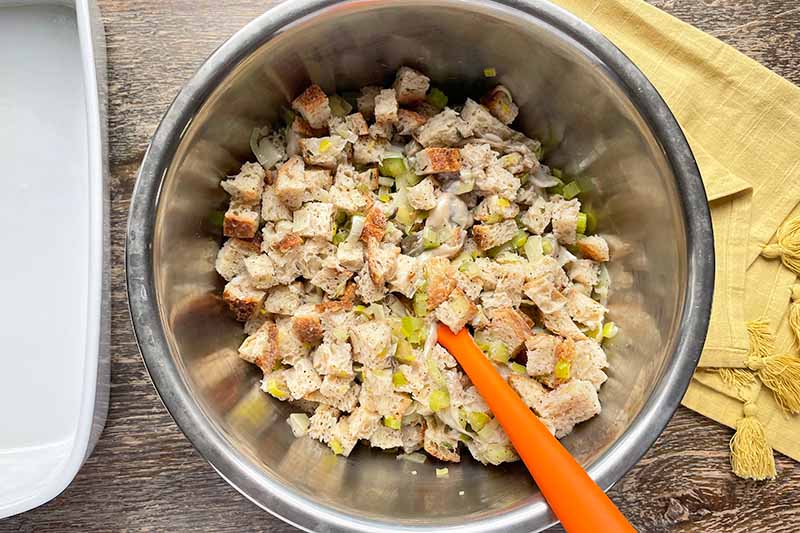
If the bread still looks somewhat dry and isn’t beginning to stick together, you can add a few additional tablespoons of stock at a time for more moisture. Just keep an eye on the bottom of the bowl because you don’t want there to be any liquid pooling there.
Transfer the bread mixture to the prepared baking dish, gently smoothing the top to evenly spread it around the pan and pushing it into the corners.
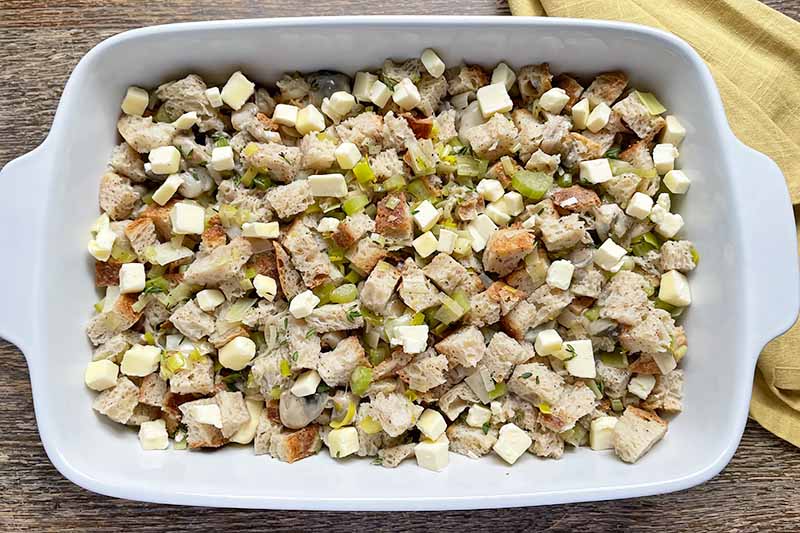
Get out the remaining cubed cold butter from the fridge and scatter it over the top so it will melt evenly into the dressing as it bakes.
Step 5 – Tent with Foil and Bake
Loosely tent the dish with foil. Bake for 20 minutes, remove the pan from the oven and take off the foil.
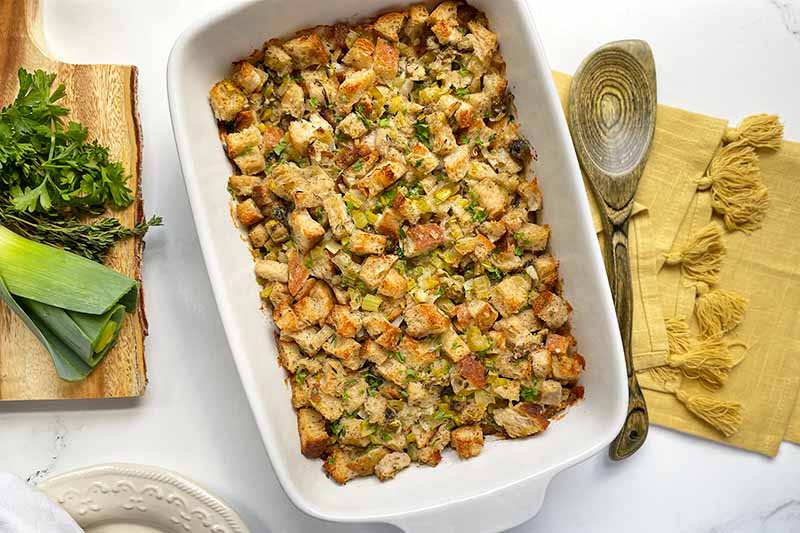
Rotate the pan so the top browns and the interior heats evenly, and bake until golden brown, for about 20 to 25 more minutes. If you know that your oven bakes unevenly, rotate the pan halfway through this final baking period for the most even browning on top.
You’ll know the dressing is ready when you give the pan a jiggle and the middle barely moves.
Step 6 – Garnish and Serve
Taste a bread cube and season the dressing with additional salt and pepper if necessary.
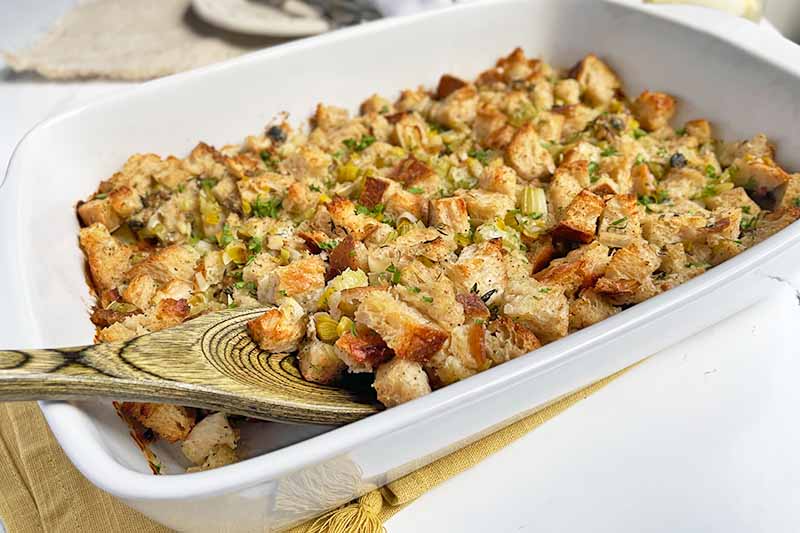
Scatter the fresh parsley over the top of the dish and serve.
But First, Bread.
I like the chewy texture and tangy flavor of sourdough, but you can use any kind of rustic white loaf – like French, Italian, or country-style bread – that’s nice and crusty.
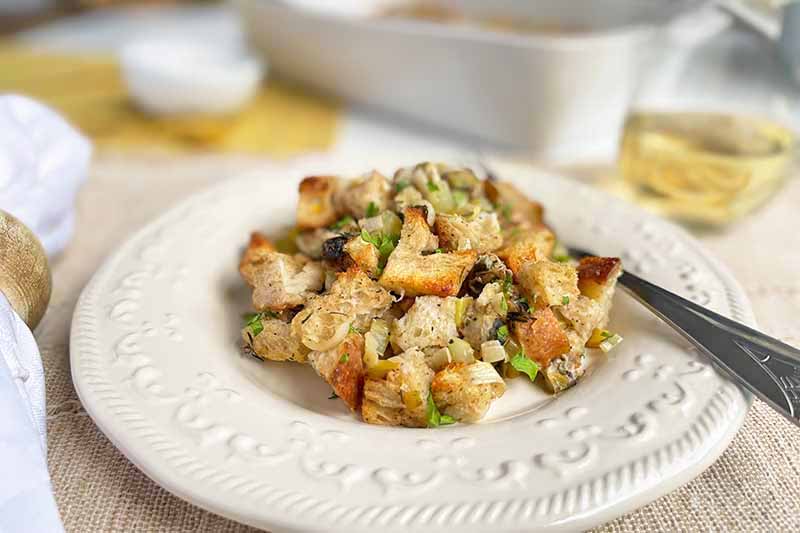
Instead of drying the bread in the oven, using day-old bread will also do the trick. As a time-saver, packaged stuffing cubes can be used as a last resort. They’re typically smaller, however, and you’ll get bigger chunks with a much more rustic texture if you take the time to slice your own bread.
To really amp up the Southern swag, snag some store bought cornbread or make our spicy jalapeno version at home. Just keep in mind that cornbread contains more moisture, which means you’ll need less liquid to moisten it, more time to dry the cubes, and the flavor profile will be sweeter and more earthy.
What kind of loaf do you like to use for your homemade stuffing? Share your bread of choice in the comments below! And don’t forget to give this recipe a five-star rating if you loved it!
Sweet, mild leeks are a staple in my aromatic bag-of-tricks. If you’re a fan of the oniony alliums too, try these recipes next:
- Mushroom, Leek, and Red Pepper Chicken Soup
- Leek and Potato Soup
- Cheesy Quiche with Leeks, Artichokes, and Roasted Red Peppers
Photos by Fanny Slater, © Ask the Experts, LLC. ALL RIGHTS RESERVED. See our TOS for more details. Originally published on November 25, 2014. Last updated on October 2, 2022.
Nutritional information derived from a database of known generic and branded foods and ingredients and was not compiled by a registered dietitian or submitted for lab testing. It should be viewed as an approximation.
About Fanny Slater
Fanny Slater is a home-taught food enthusiast based in Wilmington, North Carolina who won the “Rachael Ray Show” Great American Cookbook Competition in 2014, and published her cookbook “Orange, Lavender & Figs” in 2016. Fanny is a food and beverage writer, recipe developer, and social media influencer. She was a co-host on the Food Network series “Kitchen Sink,” was featured on Cooking Channel’s longtime popular series “The Best Thing I Ever Ate,” and continues to appear regularly on the “Rachael Ray Show.”

